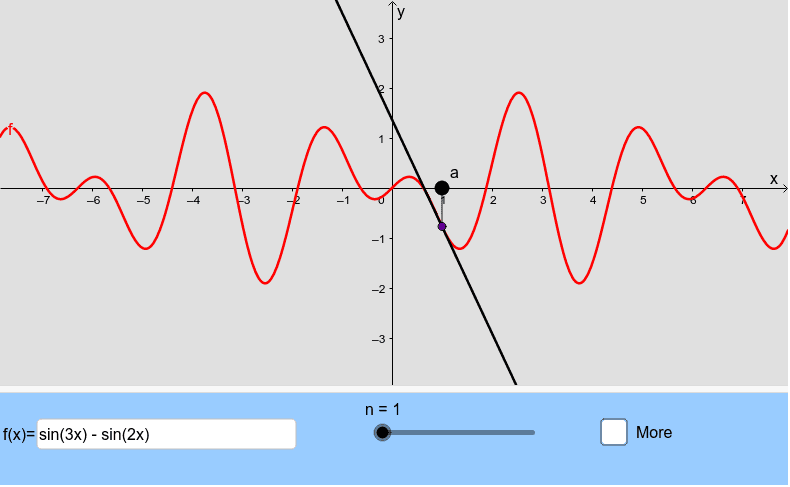5.2: Taylor Series
- Page ID
- 76224
\( \newcommand{\vecs}[1]{\overset { \scriptstyle \rightharpoonup} {\mathbf{#1}} } \)
\( \newcommand{\vecd}[1]{\overset{-\!-\!\rightharpoonup}{\vphantom{a}\smash {#1}}} \)
\( \newcommand{\id}{\mathrm{id}}\) \( \newcommand{\Span}{\mathrm{span}}\)
( \newcommand{\kernel}{\mathrm{null}\,}\) \( \newcommand{\range}{\mathrm{range}\,}\)
\( \newcommand{\RealPart}{\mathrm{Re}}\) \( \newcommand{\ImaginaryPart}{\mathrm{Im}}\)
\( \newcommand{\Argument}{\mathrm{Arg}}\) \( \newcommand{\norm}[1]{\| #1 \|}\)
\( \newcommand{\inner}[2]{\langle #1, #2 \rangle}\)
\( \newcommand{\Span}{\mathrm{span}}\)
\( \newcommand{\id}{\mathrm{id}}\)
\( \newcommand{\Span}{\mathrm{span}}\)
\( \newcommand{\kernel}{\mathrm{null}\,}\)
\( \newcommand{\range}{\mathrm{range}\,}\)
\( \newcommand{\RealPart}{\mathrm{Re}}\)
\( \newcommand{\ImaginaryPart}{\mathrm{Im}}\)
\( \newcommand{\Argument}{\mathrm{Arg}}\)
\( \newcommand{\norm}[1]{\| #1 \|}\)
\( \newcommand{\inner}[2]{\langle #1, #2 \rangle}\)
\( \newcommand{\Span}{\mathrm{span}}\) \( \newcommand{\AA}{\unicode[.8,0]{x212B}}\)
\( \newcommand{\vectorA}[1]{\vec{#1}} % arrow\)
\( \newcommand{\vectorAt}[1]{\vec{\text{#1}}} % arrow\)
\( \newcommand{\vectorB}[1]{\overset { \scriptstyle \rightharpoonup} {\mathbf{#1}} } \)
\( \newcommand{\vectorC}[1]{\textbf{#1}} \)
\( \newcommand{\vectorD}[1]{\overrightarrow{#1}} \)
\( \newcommand{\vectorDt}[1]{\overrightarrow{\text{#1}}} \)
\( \newcommand{\vectE}[1]{\overset{-\!-\!\rightharpoonup}{\vphantom{a}\smash{\mathbf {#1}}}} \)
\( \newcommand{\vecs}[1]{\overset { \scriptstyle \rightharpoonup} {\mathbf{#1}} } \)
\( \newcommand{\vecd}[1]{\overset{-\!-\!\rightharpoonup}{\vphantom{a}\smash {#1}}} \)
\(\newcommand{\avec}{\mathbf a}\) \(\newcommand{\bvec}{\mathbf b}\) \(\newcommand{\cvec}{\mathbf c}\) \(\newcommand{\dvec}{\mathbf d}\) \(\newcommand{\dtil}{\widetilde{\mathbf d}}\) \(\newcommand{\evec}{\mathbf e}\) \(\newcommand{\fvec}{\mathbf f}\) \(\newcommand{\nvec}{\mathbf n}\) \(\newcommand{\pvec}{\mathbf p}\) \(\newcommand{\qvec}{\mathbf q}\) \(\newcommand{\svec}{\mathbf s}\) \(\newcommand{\tvec}{\mathbf t}\) \(\newcommand{\uvec}{\mathbf u}\) \(\newcommand{\vvec}{\mathbf v}\) \(\newcommand{\wvec}{\mathbf w}\) \(\newcommand{\xvec}{\mathbf x}\) \(\newcommand{\yvec}{\mathbf y}\) \(\newcommand{\zvec}{\mathbf z}\) \(\newcommand{\rvec}{\mathbf r}\) \(\newcommand{\mvec}{\mathbf m}\) \(\newcommand{\zerovec}{\mathbf 0}\) \(\newcommand{\onevec}{\mathbf 1}\) \(\newcommand{\real}{\mathbb R}\) \(\newcommand{\twovec}[2]{\left[\begin{array}{r}#1 \\ #2 \end{array}\right]}\) \(\newcommand{\ctwovec}[2]{\left[\begin{array}{c}#1 \\ #2 \end{array}\right]}\) \(\newcommand{\threevec}[3]{\left[\begin{array}{r}#1 \\ #2 \\ #3 \end{array}\right]}\) \(\newcommand{\cthreevec}[3]{\left[\begin{array}{c}#1 \\ #2 \\ #3 \end{array}\right]}\) \(\newcommand{\fourvec}[4]{\left[\begin{array}{r}#1 \\ #2 \\ #3 \\ #4 \end{array}\right]}\) \(\newcommand{\cfourvec}[4]{\left[\begin{array}{c}#1 \\ #2 \\ #3 \\ #4 \end{array}\right]}\) \(\newcommand{\fivevec}[5]{\left[\begin{array}{r}#1 \\ #2 \\ #3 \\ #4 \\ #5 \\ \end{array}\right]}\) \(\newcommand{\cfivevec}[5]{\left[\begin{array}{c}#1 \\ #2 \\ #3 \\ #4 \\ #5 \\ \end{array}\right]}\) \(\newcommand{\mattwo}[4]{\left[\begin{array}{rr}#1 \amp #2 \\ #3 \amp #4 \\ \end{array}\right]}\) \(\newcommand{\laspan}[1]{\text{Span}\{#1\}}\) \(\newcommand{\bcal}{\cal B}\) \(\newcommand{\ccal}{\cal C}\) \(\newcommand{\scal}{\cal S}\) \(\newcommand{\wcal}{\cal W}\) \(\newcommand{\ecal}{\cal E}\) \(\newcommand{\coords}[2]{\left\{#1\right\}_{#2}}\) \(\newcommand{\gray}[1]{\color{gray}{#1}}\) \(\newcommand{\lgray}[1]{\color{lightgray}{#1}}\) \(\newcommand{\rank}{\operatorname{rank}}\) \(\newcommand{\row}{\text{Row}}\) \(\newcommand{\col}{\text{Col}}\) \(\renewcommand{\row}{\text{Row}}\) \(\newcommand{\nul}{\text{Nul}}\) \(\newcommand{\var}{\text{Var}}\) \(\newcommand{\corr}{\text{corr}}\) \(\newcommand{\len}[1]{\left|#1\right|}\) \(\newcommand{\bbar}{\overline{\bvec}}\) \(\newcommand{\bhat}{\widehat{\bvec}}\) \(\newcommand{\bperp}{\bvec^\perp}\) \(\newcommand{\xhat}{\widehat{\xvec}}\) \(\newcommand{\vhat}{\widehat{\vvec}}\) \(\newcommand{\uhat}{\widehat{\uvec}}\) \(\newcommand{\what}{\widehat{\wvec}}\) \(\newcommand{\Sighat}{\widehat{\Sigma}}\) \(\newcommand{\lt}{<}\) \(\newcommand{\gt}{>}\) \(\newcommand{\amp}{&}\) \(\definecolor{fillinmathshade}{gray}{0.9}\)For Real Functions
Let \(a\in \mathbb R\) and \(f(x)\) be and infinitely differentiable function on an interval \(I\) containing \(a\). Then the one-dimensional Taylor series of \(f\) around \(a\) is given by
\(f(x)=f(a)+f’(a)(x-a)+\frac{f’’(a)}{2!}(x-a)^2+\frac{f^{(3)}(a)}{3!}(x-a)^3+\cdots\)
which can be written in the most compact form:
\(f(x)=\sum_{n=0}^{\infty} \frac{f^{(n)}(a)}{n!}(x-a)^n.\)
Recall that, in real analysis, Taylor’s theorem gives an approximation of a \(k\)-times differentiable function around a given point by a \(k\)-th order Taylor polynomial.
For example, the best linear approximation for \(f(x)\) is
\(f(x)\approx f(a)+f′(a)(x−a).\)
This linear approximation fits \(f(x)\) with a line through \(x=a\) that matches the slope of \(f\) at \(a\).
For a better approximation we can add other terms in the expansion. For instance, the best quadratic approximation is
\(f(x)\approx f(a)+f’(a)(x−a)+\frac12 f’’(a)(x−a)^2.\)
The following applet shows the partial sums of the Taylor series for a given function. Drag the slider to show more terms of the series. Drag the point a or change the function.

INTERACTIVE GRAPH
For Complex Functions
Suppose that a function \(f\) is analytic throughout a disk \(|z -z_0|< R\), centred at \(z_0\) and with radius \(R_0\). Then \(f(z)\) has the power series representation
\(\begin{eqnarray}\label{seriefunction}
f(z)=\sum_{n=0}^{\infty} a_n(z-z_0)^n,\quad |z-z_0|<R,
\end{eqnarray}\)
where
\(\begin{eqnarray}
a_n=\frac{f^{(n)}(z_0)}{n!},\quad n=0,1,2,\ldots
\end{eqnarray}
\)
That is, series (1) converges to \(f(z)\) when \(z\) lies in the stated open disk.
Every complex power series (1) has a radius of convergence. Analogous to the concept of an interval of convergence for real power series, a complex power series (1) has a circle of convergence, which is the circle centered at \(z_0\) of largest radius \(R>0\) for which (1) converges at every point within the circle \(|z−z_0|=R\). A power series converges absolutely at all points \(z\) within its circle of convergence, that is, for all \(z\) satisfying \(|z−z_0|<R\), and diverges at all points \(z\) exterior to the circle, that is, for all \(z\) satisfying \(|z−z_0|>R\). The radius of convergence can be:
- \(R=0\) (in which case (1) converges only at its center \(z=z_0\)),
- \(R\) a finite positive number (in which case (1) converges at all interior points of the circle \(|z−z_0|<R\), or
- \(R=∞\) (in which case (1) converges for all \(z\)).
The radius of convergence can be calculated using the ratio test of convergece. For example, if:
- \(\displaystyle \lim_{n\rightarrow \infty} \left| \frac{a_{n+1}}{a_n}\right| = L\neq 0\), the radius of convergence is \(R=\dfrac{1}{L}\);
- \(\displaystyle \lim_{n\rightarrow \infty} \left| \frac{a_{n+1}}{a_n}\right|= 0\), the radius of convergence is \(R=∞\);
- \(\displaystyle \lim_{n\rightarrow \infty} \left| \frac{a_{n+1}}{a_n}\right|= \infty\), the radius of convergence is \(R=0\).
Dynamic Exploration
Use the following applet to explore Taylor series representations and its radius of convergence which depends on the value of \(z_0\).
On the left side of the applet below, a phase portrait of a complex function is displayed. On the right side, you can see the approximation of the function through it’s Taylor polynomials at the blue base point \(z_0\). The complex function, the base point \(z_0\), the order of the polynomial (vertical slider) and the zoom (horizontal slider) can be modified.
INTERACTIVE GRAPH
Maclaurin series
A Taylor series with centre \(z_0=0\)
\(f(z) = \sum_{n=0}^{\infty} \frac{f^{(n)}(0)}{n!}z^n\)
is referred to as Maclaurin series.
Some important Maclaurin series are:
\(\begin{eqnarray*}
\displaystyle \frac{1}{1-z}&=& \sum_{n=0}^{\infty} z^n, \quad |z|\lt 1; \\
\displaystyle e^z &=& \sum_{n=0}^{\infty} \frac{z^n}{n!} \quad |z|\lt \infty;\\
\displaystyle \sin z &=& \sum_{n=0}^{\infty} (-1)^n\frac{z^{2n+1}}{n!} \quad |z|\lt \infty;\\
\displaystyle \cos z &=& \sum_{n=0}^{\infty} (-1)^n \frac{z^{2n}}{n!} \quad |z|\lt \infty;\\
\displaystyle \sinh z &=& \sum_{n=0}^{\infty} \frac{z^{2n+1}}{n!} \quad |z|\lt \infty;\\
\displaystyle \cosh z &=& \sum_{n=0}^{\infty} \frac{z^{2n}}{n!} \quad |z|\lt \infty;
\end{eqnarray*}\)
Exercise \(\PageIndex{1}\)
Exercise: Find the Maclaurin series expansion of the function
\(f(z)=\frac{z}{z^4+9}\)
and calculate the radius of convergence.
Note
The applet was originally written by Aaron Montag using CindyJS. The source can be found at GitHub.


